
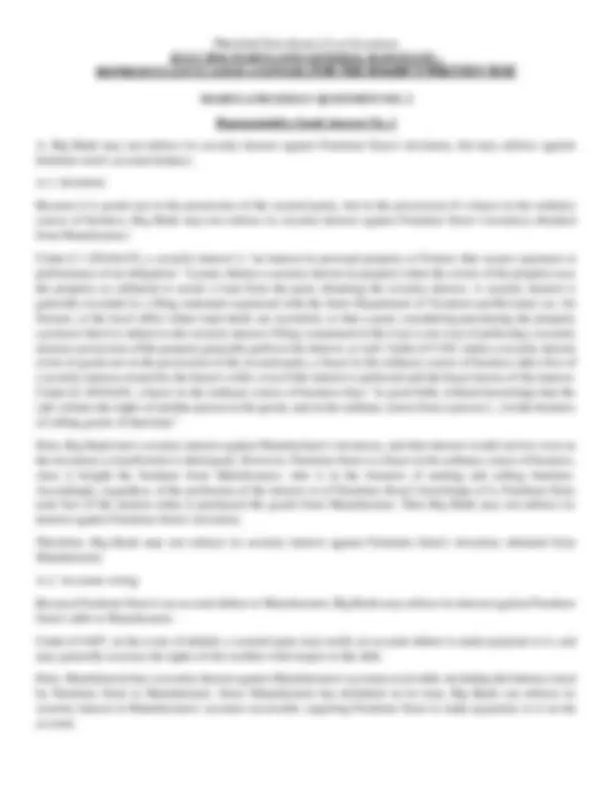
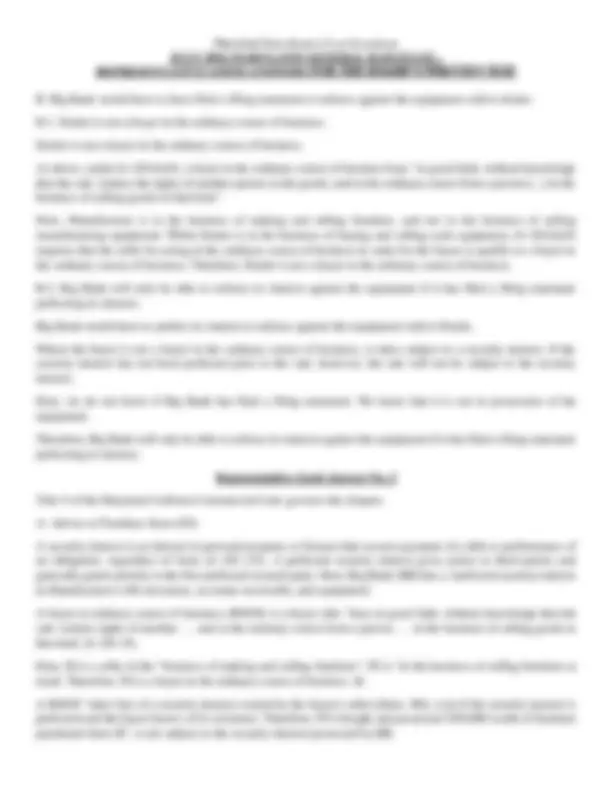



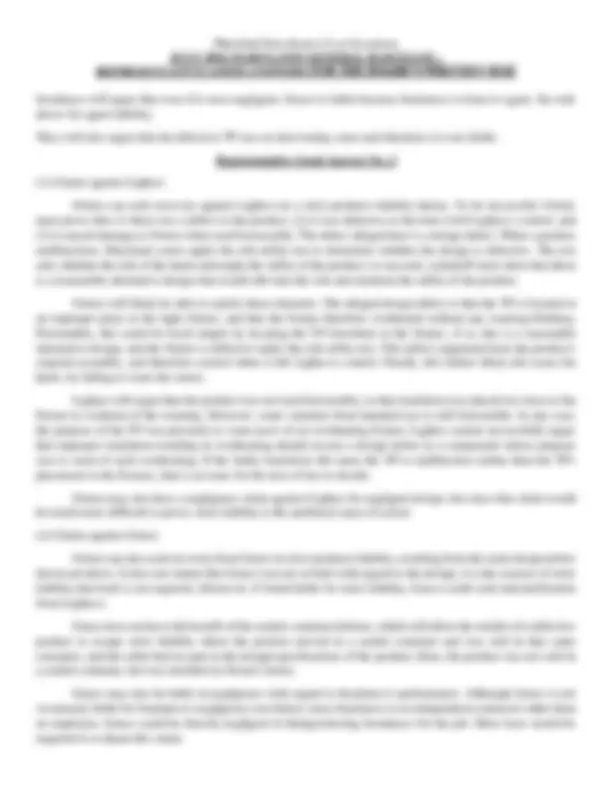
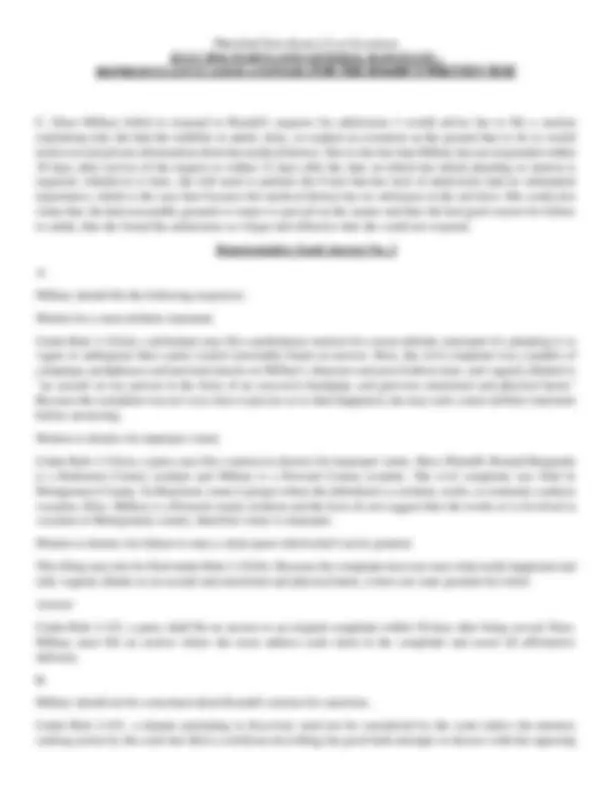
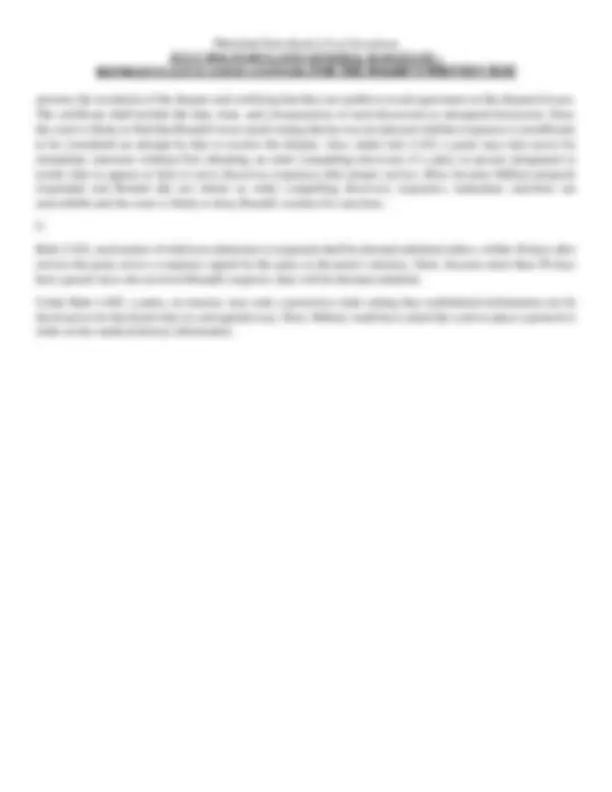
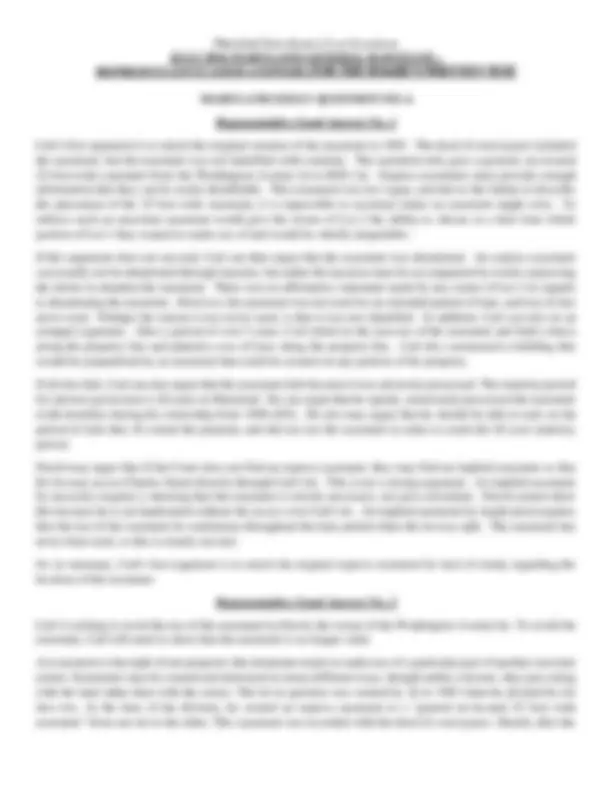
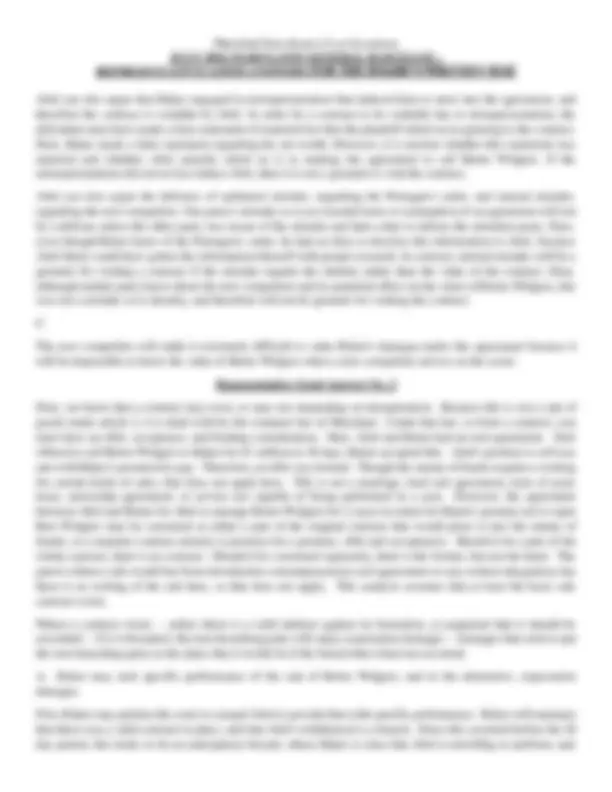
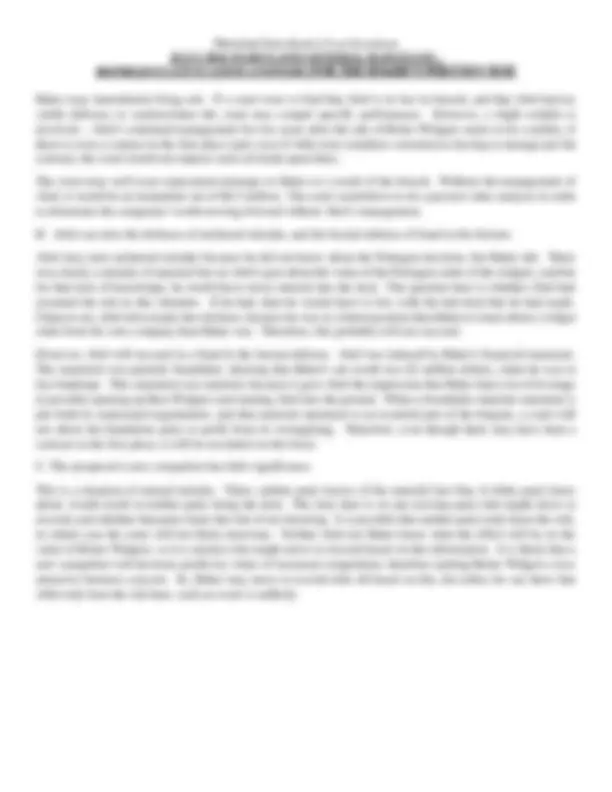
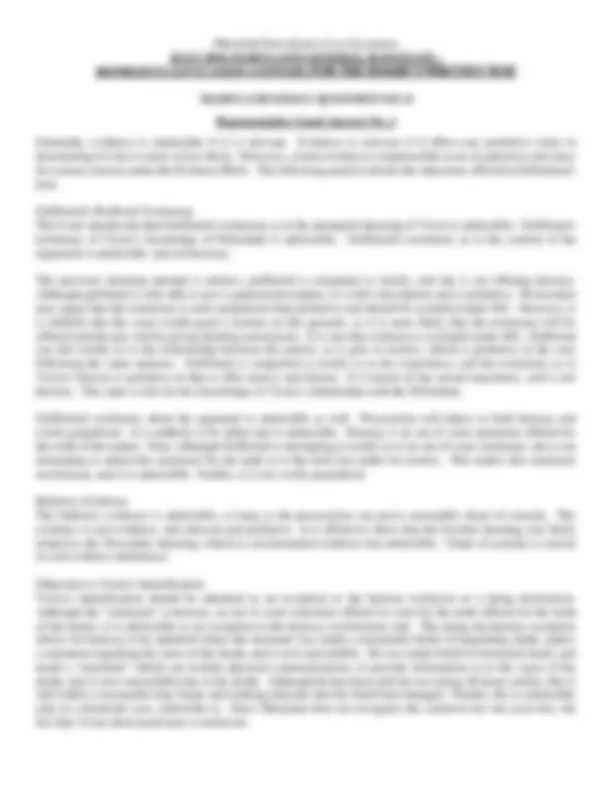
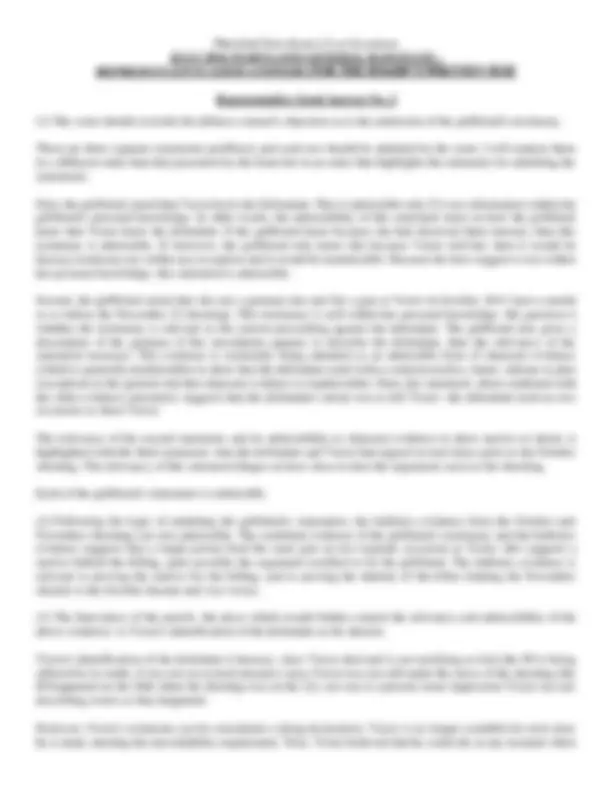

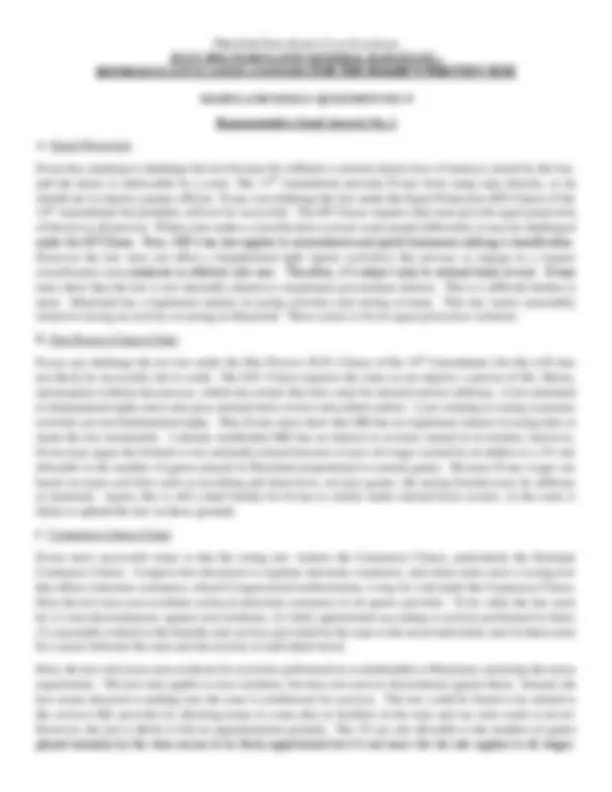
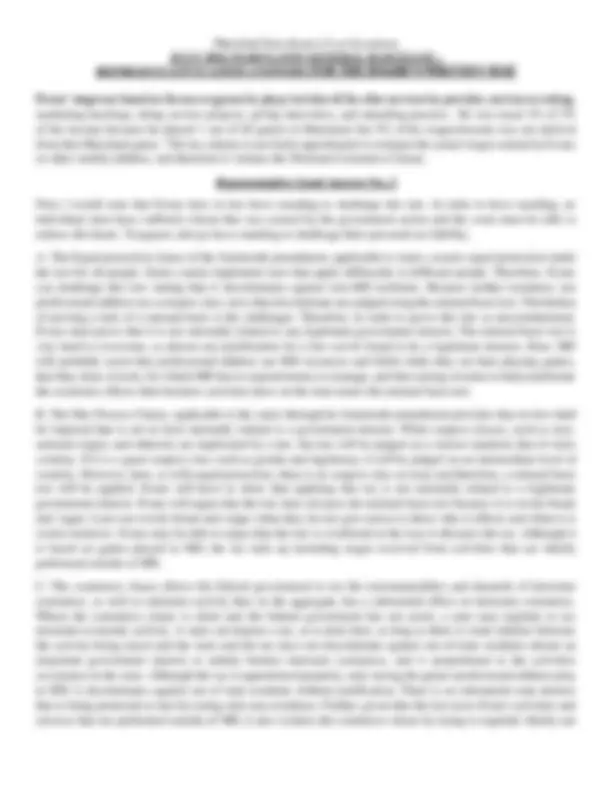

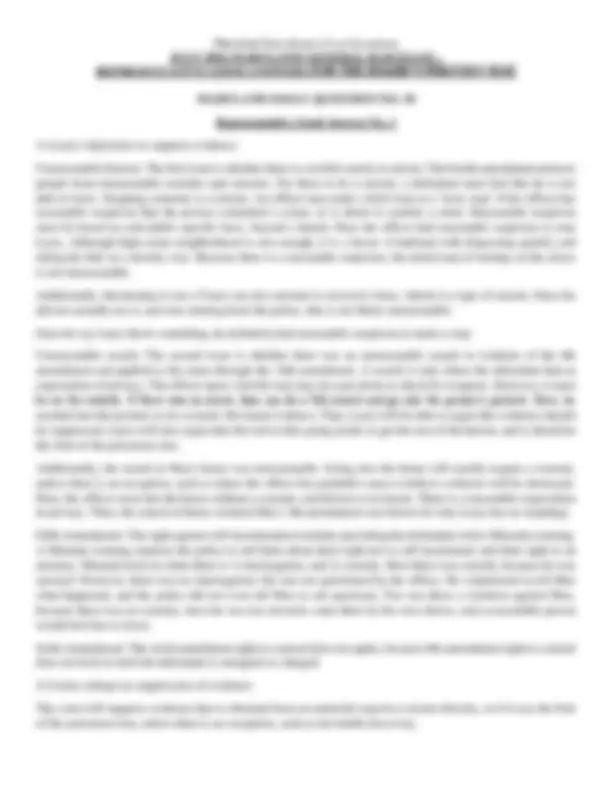
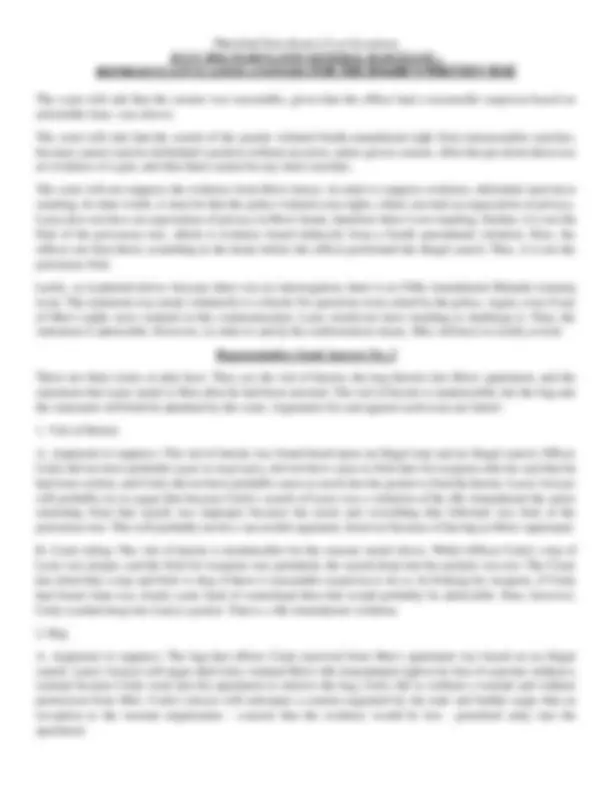
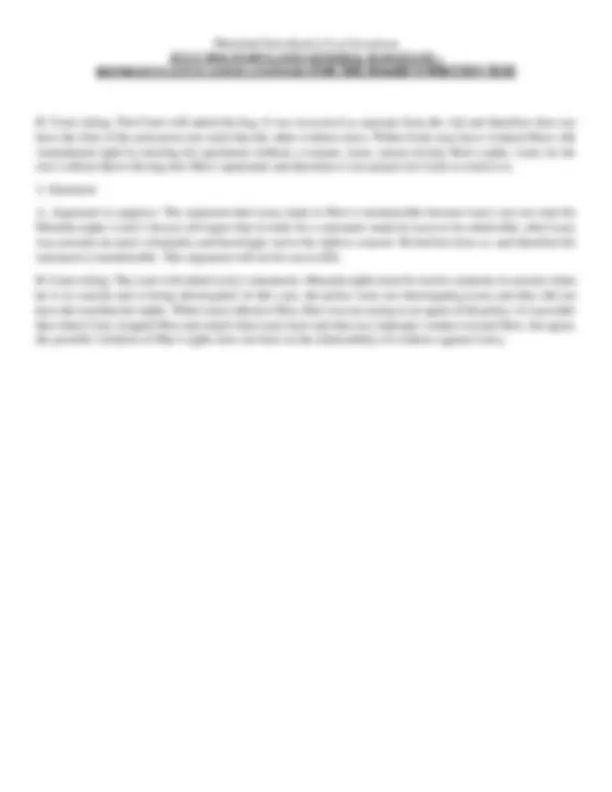
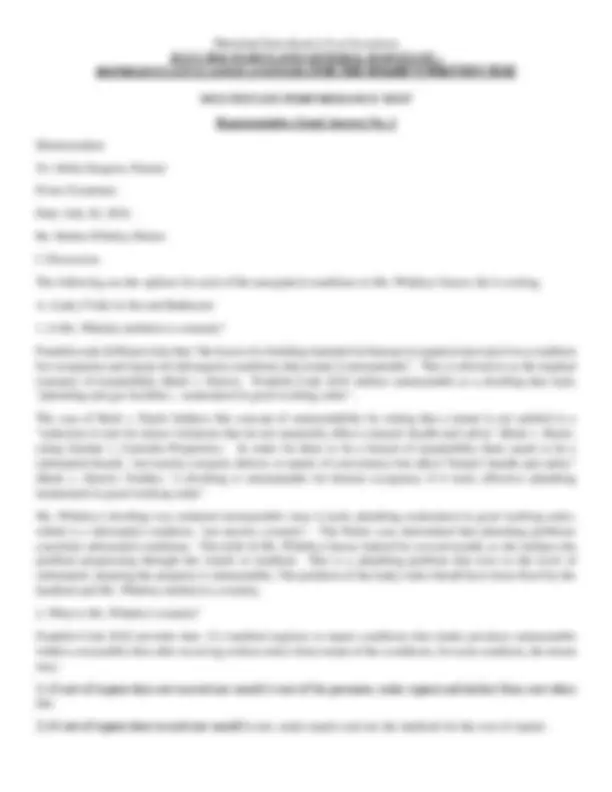
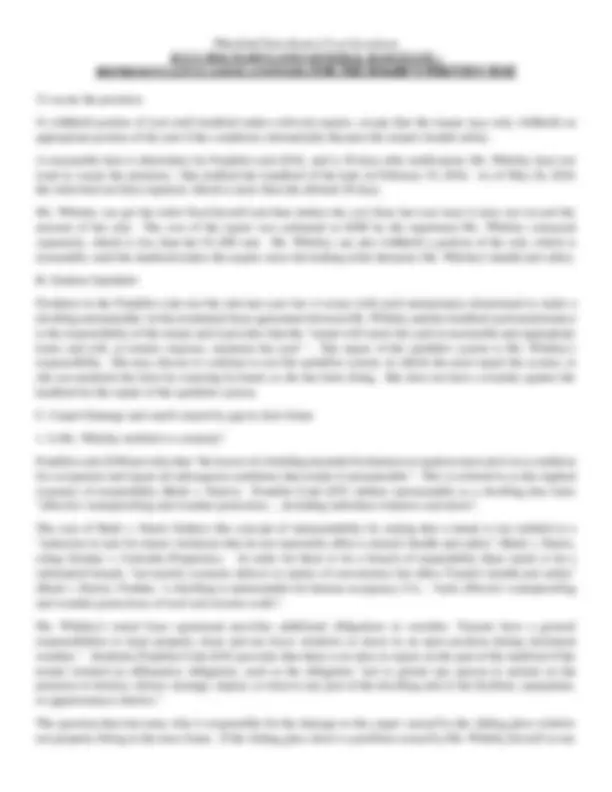
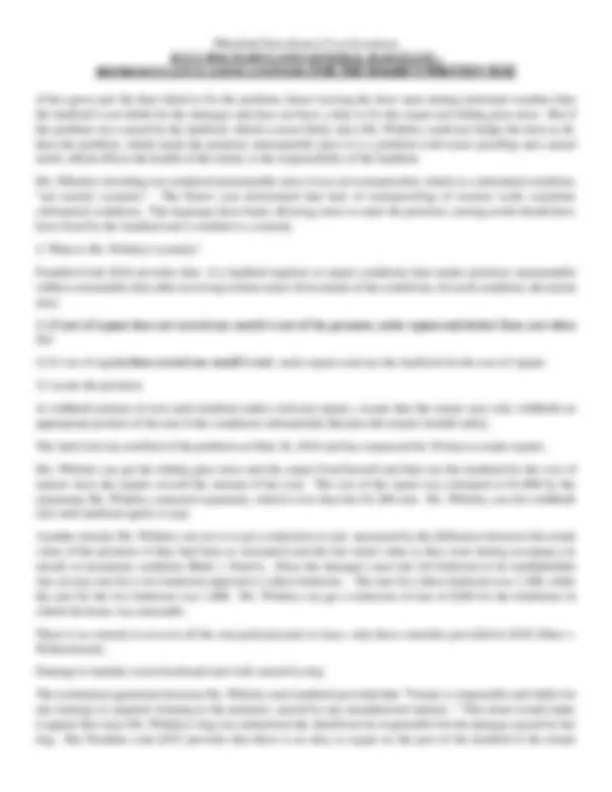
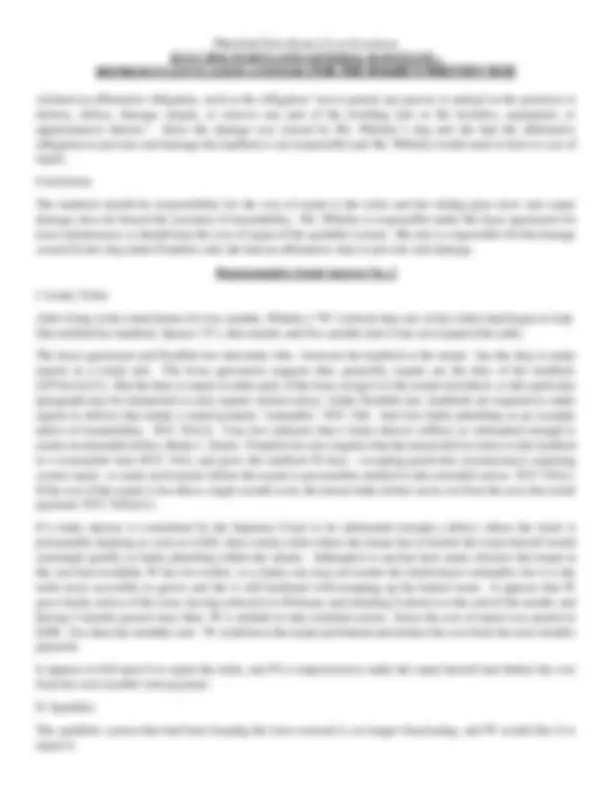
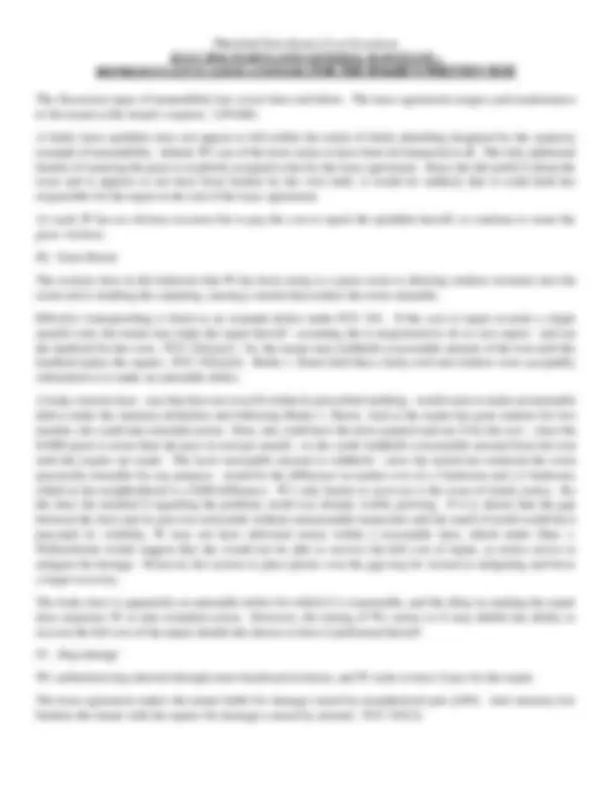
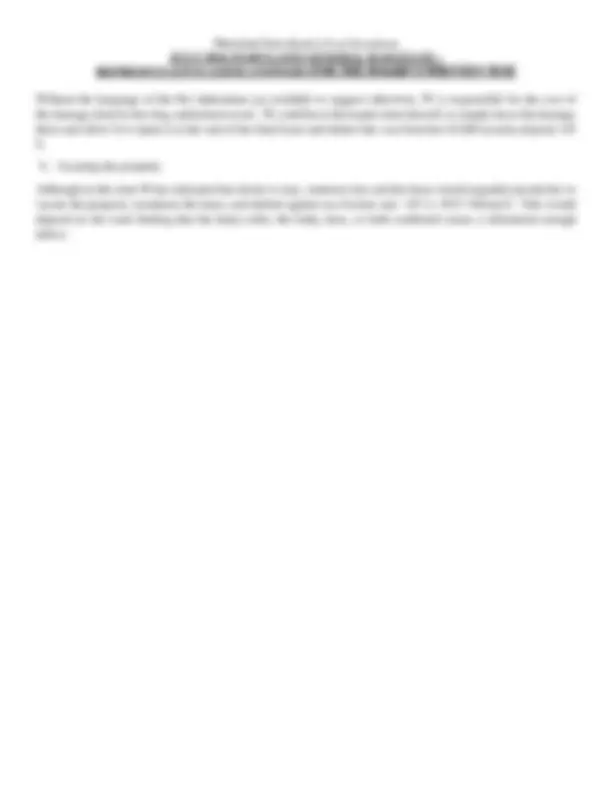


Study with the several resources on Docsity

Earn points by helping other students or get them with a premium plan


Prepare for your exams
Study with the several resources on Docsity

Earn points to download
Earn points by helping other students or get them with a premium plan
Community
Ask the community for help and clear up your study doubts
Discover the best universities in your country according to Docsity users
Free resources
Download our free guides on studying techniques, anxiety management strategies, and thesis advice from Docsity tutors
Representative good answers for the Maryland Bar Exam written test, focusing on marital property and landlord-tenant law. Topics covered include the classification of marital property, the distribution of pensions and retirement benefits, the status of investment accounts, and the landlord's duty to repair. The document also discusses various legal issues such as anticipatory breach, misrepresentation, and the application of Maryland State codes.
Typology: Study Guides, Projects, Research
1 / 34

This page cannot be seen from the preview
Don't miss anything!



























NOTICE: These Representative Good Answers are provided to illustrate how actual examinees responded to the Maryland essay questions and the Multistate Performance Test (MPT). The Representative Good Answers are not “average” passing answers nor are they necessarily “perfect” answers. Instead, they are responses which, in the Board’s view, illustrate successful answers written by applicants who passed the Maryland General Bar Examination. These answers are reproduced without any changes or corrections by the Board, other than to spelling and formatting for ease of reading.
MARYLAND ESSAY QUESTION NO. 1
Representative Good Answer No. 1
A. Broke should file a Motion to Dismiss for failure to state a claim upon which relief can be granted and lack of personal jurisdiction. The success of this motion will depend on whether Sloppy's owners will successfully leverage either the de facto corporation defense or corporation by estoppel equitable defense.
In Maryland, a corporation is a separate legal entity that enjoys the same privileges and obligations as an individual including the right to sue and be sued. When a corporation is administratively dissolved, it is no longer a legal entity and becomes a legal nullity. It thus loses its ability to sue in Maryland courts. However, when there is a forfeiture by the state of Maryland, a corporation has 60 days to remedy the problem before its charter is revoked. Thereafter, the owners of the corporation must file Articles of Revival to have the charter reinstated.
Here, Sloppy's charter was revoked in 2012. Thereafter it was no longer a legal entity recognized under Maryland law and thus is not a party that may bring suit to defend its rights. This suit was filed on behalf of Sloppy on January 2, 2016. One day later the expiration of the statute of limitations occurred. While the forfeiture was discovered three weeks later and the corporation successfully filed and were permitted to revive the corporate charter, when the statute of limitations for this claim passed, Sloppy was still a non-entity. Thus, Broke may argue that there was no actual suit when it was filed as there was no entity that could so file a suit. Hence, there is no claim for relief to be granted because it is barred by the statute of limitations. Alternatively, Broke can argue that there is no personal jurisdiction over one of the parties here because there is no party over which to have personal jurisdiction.
While a strong claim, it may be defeated if Sloppy's owners successfully leverage ether the de facto corporation defense or the corporation by estoppel defense. Both of these are used when a corporation fails to incorporate and its owners attempt to enforce contracts made against third parties. In order for party to successful use the de facto corporation defense, it must show that there is a relevant incorporation statute, there was a colorable, good faith attempt to comply and the corporation availed itself of corporate privileges. This defense has an unclear basis in Maryland but has not been affirmatively rejected by state courts. Corporation by estoppel is an equitable defense used by owners of an entity. Corporation by estoppel requires that a third party do business with an entity it knows to be holding itself out as a corporation and do business in reliance on that holding out. The owners of the non-incorporated entity must make a good faith effort to comply with the statute and must in good faith engage in business with the third party (i.e. without notice of the incorporation error).
Here, the de facto corporation defense and corporation by estoppel defense will hinge on whether a court will determine a colorable good faith attempt to comply with the incorporation requirements are met. The forfeiture occurred in 2012. Sloppy did not discover the forfeiture until 2016--four years later. Assuming that SDAT sent appropriate notification of the forfeiture to Sloppy, its negligence in discovering the forfeiture throughout such an extended amount of time will work against it and likely defeat these defenses. If a court determines that there
was a good faith attempt, the strongest argument will be for corporation by estoppel as it has the clearest basis in Maryland if it can be shown that Broke knew that Sloppy was a corporation when it made the Note. More facts are required to determine when the Note was in fact made.
B. Bob is unlikely to be personally liable for the Contract. When a corporation’s charter is revoked by forfeiture it is no longer a legal entity. Thus, any individual who enters into contracts on behalf of the corporation after its charter is revoked is personally liable on that contract obligation. Thereafter, if the corporation's charter is revived/reinstated, the corporation becomes liable on any pre-revival contracts entered into by its agents.
Here, Bob was Sloppy's president. He is likely authorized to enter into contracts on behalf of the corporation. However, he entered into this contract after forfeiture took place and thus was personally liable up until the charter was revived on January 22 or about that time. The breach of contract suit was not brought until March 2016 after revival had taken place and therefore, Sloppy is now liable for that pre-revival contract entered into by Bob.
While in the case of a promoter that enters into contracts prior to incorporation remains personally liable until a novation occurs, a novation is not required when a corporation's charter is revived and reinstated.
Representative Good Answer No. 2
A. A corporation that has been forfeited may not sue to collect on a debt during the time in which the corporation is forfeited. Broke may seek a motion to dismiss for failure to state a claim upon which relief can be granted because at the time when Sloppy filed a lawsuit, on Jan. 2, 2016, Sloppy was no longer in good standing. If Sloppy is not in good standing, then they cannot bring a lawsuit to recover. However, if a corporation discovers the forfeiture and files the appropriate Articles of Revival and successfully revives its charter, as Sloppy did here, then all actions related to the corporation that the corporation took during the time of forfeiture will be fully enforceable.
Broke may, however, be successful on a motion to dismiss because the statute of limitations had passed before Sloppy was revived and thus once they became revived again, they would be barred from bringing an action to against Broke because the statute of limitations had passed.
Thus, the court should grant the Motion to Dismiss because at the time Sloppy revived the corporation, the sol
B. This question involves agency and authority. A president of a corporation has actual authority to act on behalf of a Corporation and as long as the Corporation is in good standing, the actions of the President as an agent for the Corporation will bind the Corporation. However, if the Corporation is not in good standing and the President makes a contract on behalf of the Corporation, the Contract is not enforceable except upon the filing of articles of revival and successfully reviving the corporation. Only once the corporation is revived may the corporation become liable for contracts entered into during the time of forfeiture by an agent of the corporation. Here, Bob is the president of the corporation and as such has actual authority to act on behalf of the corporation. Because the Corporation revived its charter in March 2016, the president, Bob will not be personally liable for the lawsuits regarding the contracts that were entered into by him in 2014, as agent for Sloppy during the time of forfeiture. Once revived, Sloppy is liable for a breach of contract that was entered into by the President, Bob, as agent for Sloppy. Bob is not personally liable.
B. Big Bank would have to have filed a filing statement to enforce against the equipment sold to dealer.
B.1. Dealer is not a buyer in the ordinary course of business.
Dealer is not a buyer in the ordinary course of business.
As above, under §1-201(b)(9), a buyer in the ordinary course of business buys "in good faith, without knowledge that the sale violates the rights of another person in the goods, and in the ordinary course from a person [...] in the business of selling goods of that kind."
Here, Manufacturer is in the business of making and selling furniture, and not in the business of selling manufacturing equipment. While Dealer is in the business of buying and selling such equipment, §1-201(b)(9) requires that the seller be acting in the ordinary course of business in order for the buyer to qualify as a buyer in the ordinary course of business. Therefore, Dealer is not a buyer in the ordinary course of business.
B.2. Big Bank will only be able to enforce its interest against the equipment if it has filed a filing statement perfecting its interest.
Big Bank would have to perfect its interest to enforce against the equipment sold to Dealer.
Where the buyer is not a buyer in the ordinary course of business, it takes subject to a security interest. If the security interest has not been perfected prior to the sale, however, the sale will not be subject to the security interest.
Here, we do not know if Big Bank has filed a filing statement. We know that it is not in possession of the equipment.
Therefore, Big Bank will only be able to enforce its interest against the equipment if it has filed a filing statement perfecting its interest.
Representative Good Answer No. 2
Title 9 of the Maryland Uniform Commercial Code governs this dispute.
A. Advise to Furniture Store (FS)
A security interest is an interest in personal property or fixtures that secures payment of a debt or performance of an obligation, regardless of form. §1-201 (35). A perfected security interest gives notice to third parties and generally grants priority to the first perfected secured party. Here, Big Bank (BB) has a "perfected security interest in Manufacturer's (M) inventory, accounts receivable, and equipment'.
A buyer in ordinary course of business (BOCB) is a buyer who "buys in good faith, without knowledge that the sale violates rights of another... and in the ordinary course from a person... in the business of selling goods in that kind. §1-201 (9).
Here, M is a seller in the "business of making and selling furniture". FS is "in the business of selling furniture at retail. Therefore, FS is a buyer in the ordinary course of business. Id.
A BOCB "takes free of a security interest created by the buyer's seller [(here, M)], even if the security interest is perfected and the buyer knows of its existence. Therefore, FS's bought and possessed '$50,000 worth of furniture purchased from M", is not subject to the security interest possessed by BB.
Owners of a security interest in inventory are presumed to have rights to the proceeds of the inventory after sale. BB therefor has rights to the "$25,000 [which] has been paid" by FS, and may collect this from M since M has "default[ed] on its loan from BB". "[A] secured party... may take any proceeds to which the secured party is entitled". §9-607(a)(2)
BB also has an interest and may collect from FS the $25,000 "remain[ing]" "due and owing" from FS to M. ""[A] secured party... may enforce the obligations of an account debtor.. ." §9-607(a)(3)
B. Advice to Dealer
Generally, once a security interest attaches (value given by creditor, debtor has rights in collateral, and an agreement exists) to personal property of another, the security interest follows the property, even if the property is sold to a third party, here Dealer (D).
An exception exists for buyers in ordinary course of business (BOCB). A BOCB is a buyer who "buys in good faith, without knowledge that the sale violates rights of another... and in the ordinary course from a person... in the business of selling goods in that kind. §1-201 (9).
Here, while D is "in the business of buying and selling used equipment", M is not in such business, rather, they are in the business of making and selling furniture. Therefore, D is not a BOCB.
As D is not a BOCB, D takes the equipment subject to BB's security interest. BB may enforce its security interest against D, in addition or in lieu of collecting the proceeds of the sale of the equipment to D, as discussed above.
BB may enforce the security interest in the equipment against D upon M's default.
Part D
This part is governed by the Maryland Rules of Professional conduct.
Lawyers have a duty of honesty. Here, W has a pension from her job as a nurse, but told her attorney she did not want H to get any of her pension and the attorney recommended that W did not have to list her pension in discovery responses, which is dishonest, and a violation of this rule.
Candor to the tribunal. See above.
Lawyers have a may not impeded an opposing party's investigation. Here, the lawyer recommending W not list her pension has marital property, and advise W not to discuss the pension with H, may be a violation because it impedes the investigation of the opposing party.
Lawyers owe their clients a duty of competent representation. Here, the lawyer’s advice that because H did not list his pension as marital property, so W did not either, is not sound or competent advice, and thus is a violation.
Rule 8.4 is a rule against general misconduct. Here, for all of the above violations, the lawyer has also violated rule 8.
Representative Good Answer No. 2
A. Status of House
In 2008, H purchased the house solely in his name with the proceeds of his own personal settlement. This would seem to indicate that the home is owned solely by H at that time. However, H&W married shortly before the purchase and despite the initial indications that it was the separate property of H, it was used as the family home. In 2010 they changed the ownership status from solely H to H&W as tenants by the entireties. This is a status of ownership only offered to married couples and clearly shows the house is jointly owned.
Additionally, H & W jointly took out a home equity loan and received the proceeds by check payable to them both for $287,000.
Finally, until W filed for divorce they continued to use the home as the marital home and make mortgage payments from their joint account. This is clear marital property from 2010 until the time of the divorce.
B. Status of Grow Your Money
There is a presumption in MD that things acquired by a couple during marriage, and that use marital funds for purchase, are marital property. Here, even though Grow-Your-Money (GYM) was titled only to H, it was completely funded with marital funds, namely a 287,000 check proceeds jointly written to H&W, and $13, from a joint account.
Based on the MD presumption and the money tracing back to a marital funds origin, this is (and likely always was marital property at divorce.
C. Equitable Distribution of W’s Pension
Because W and H have been married less than 10 years, H’s claims on W’s pension may be limited. However, as a general rule, pension proceeds if earned during marriage, are marital property subject to equitable distribution.
Therefore, when W retires (not at the divorce) and she begins to receive her pension, a portion of those proceeds are to be distributed to H as his portion of marital property. Unless H&W by separate agreement agreed otherwise.
D. The Attorney’s Ethics Violation
W’s attorney violated his duty of honesty by encouraging his client to withhold information about the pension when she is not allowed to do so.
Further, if he was unaware of the fact that all property needed to be listed in the discovery responses, then he has violated the duty of competence. He is not necessarily required to know offhand, but certainly has a duty to investigate and report correct information to his client.
Further, he has violated his duty of candor to the court by filing knowingly false documents with court, as well.
Insulateco will argue that even if it were negligent, Genco is liable because Insulateco is Genco's agent. See rule above for agent liability.
They will also argue that the defective TP was an intervening cause and therefore it is not liable.
Representative Good Answer No. 2
(1) Claims against Lightco
Owner can seek recovery against Lightco on a strict products liability theory. To be successful, Owner must prove that (1) there was a defect in the product, (2) it was defective at the time it left Lightco's control, and (3) it caused damage to Owner when used foreseeably. The defect alleged here is a design defect. When a product malfunctions, Maryland courts apply the risk-utility test to determine whether the design is defective. The test asks whether the risk of the harm outweighs the utility of the product; to succeed, a plaintiff must show that there is a reasonable alternative design that would alleviate the risk and maintain the utility of the product.
Owner will likely be able to satisfy these elements. The alleged design defect is that the TP is located in an improper place in the light fixture, and that the fixture therefore overheated without any warning blinking. Presumably, this could be fixed simply by locating the TP elsewhere in the fixture; if so, this is a reasonable alternative design, and the fixture is defective under the risk utility test. This defect originated from the product's original assembly, and therefore existed when it left Lightco's control. Finally, this failure likely did cause the harm, by failing to warn the owner.
Lightco will argue that the product was not used foreseeably, in that insulation was placed too close to the fixture in violation of the warning. However, some variation from intended use is still foreseeable. In any case, the purpose of the TP was precisely to warn users of an overheating fixture; Lightco cannot successfully argue that improper insulation resulting in overheating should excuse a design defect in a component whose purpose was to warn of such overheating. If the faulty insulation did cause the TP to malfunction (rather than the TP's placement in the fixture), that is an issue for the trier of fact to decide.
Owner may also have a negligence claim against Lightco for negligent design, but since that claim would be much more difficult to prove, strict liability is the preferred cause of action
(2) Claims against Genco
Owner can also seek recovery from Genco in strict products liability, resulting from the same design defect discussed above. It does not matter that Genco was not at fault with regard to the design; it is the essence of strict liability that fault is not required. (However, if found liable for strict liability, Genco could seek indemnification from Lightco).
Genco does not have the benefit of the sealed-container defense, which will allow the retailer of a defective product to escape strict liability where the product arrived in a sealed container and was sold in that same container, and the seller had no part in the design/specifications of the product. Here, the product was not sold in a sealed container, but was installed in Owner's home.
Genco may also be liable in negligence with regard to Insulateco's performance. Although Genco is not vicariously liable for Insulateco's negligence (see below) since Insulateco is an independent contractor rather than an employee, Genco could be directly negligent in hiring/selecting Insulateco for the job. More facts would be required to evaluate this claim.
(3) Claims against Insulateco
Insulateco is likely negligent for installing insulation too close to the fixture. Negligence requires duty, breach, causation, and damages; all of these are likely satisfied here. As an insulation contractor, Insulateco is held to the standard of care of other such businesses, which presumably know not to insulate hot light fixtures too tightly. Moreover, the warning on the fixture put Insulateco on notice of these requirements. If the too-close insulation caused the fire--as the fire marshal indicated--Insulateco will be liable for negligence.
C. Since Millary failed to respond to Ronald's requests for admissions I would advise her to file a motion explaining why she had the inability to admit, deny, or explain an averment on the ground that to do so would tend to reveal private information about her medical history. Due to the fact that Millary has not responded within 30 days after service of the request or within 15 days after the date on which her initial pleading or motion is required, whichever is later, she will need to petition the Court that her lack of admissions had no substantial importance, which is the case here because her medical history has no substance in the suit here. She could also claim that she had reasonable grounds to expect to prevail on the matter and that she had good reason for failure to admit, that she found the admissions so vulgar and offensive that she could not respond.
Representative Good Answer No. 2
A.
Millary should file the following responses:
Motion for a more definite statement
Under Rule 2-322(d), a defendant may file a preliminary motion for a more definite statement if a pleading is so vague or ambiguous that a party cannot reasonably frame an answer. Here, the civil complaint was a jumble of campaign catchphrases and personal attacks on Millary's character and poor fashion taste, and vaguely alluded to "an assault on my person in the form of an excessive handgrip, and grievous emotional and physical harm." Because the complaint was not very clear or precise as to what happened, she may seek a more definite statement before answering.
Motion to dismiss for improper venue.
Under Rule 2-322(a), a party may file a motion to dismiss for improper venue. Here, Plaintiff, Ronald Burgundy is a Baltimore County resident and Millary is a Howard County resident. The civil complaint was filed in Montgomery County. In Maryland, venue is proper where the defendant is a resident, works, or routinely conducts vocation. Here, Millary is a Howard county resident and the facts do not suggest that she works or is involved in vocation in Montgomery county, therefore venue is improper.
Motion to dismiss for failure to state a claim upon which relief can be granted.
This filing may also be filed under Rule 2-322(b). Because the complaint does not state what really happened and only vaguely alludes to an assault and emotional and physical harm, it does not state grounds for relief.
Answer
Under Rule 2-321, a party shall file an answer to an original complaint within 30 days after being served. Here, Millary must file an answer where she must address each claim in the complaint and assert all affirmative defenses.
B.
Millary should not be concerned about Ronald's motion for sanctions.
Under Rule 2-431, a dispute pertaining to discovery need not be considered by the court unless the attorney seeking action by the court has filed a certificate describing the good faith attempts to discuss with the opposing
attorney the resolution of the dispute and certifying that they are unable to reach agreement on the disputed issues. The certificate shall include the date, time, and circumstances of each discussion or attempted discussion. Here, the court is likely to find that Ronald's terse email stating that he was not pleased with her responses is insufficient to be considered an attempt by him to resolve the dispute. Also, under rule 2-432, a party may only move for immediate sanctions without first obtaining an order compelling discovery if a party or person designated to testify fails to appear or fails to serve discovery responses after proper service. Here, because Millary properly responded and Ronald did not obtain an order compelling discovery responses, immediate sanctions are unavailable and the court is likely to deny Ronald's motion for sanctions.
C.
Rule 2-424, each matter of which an admission is requested shall be deemed admitted unless, within 30 days after service the party serves a response signed by the party or the party's attorney. Here, because more than 30 days have passed since she received Ronald's requests, they will be deemed admitted.
Under Rule 2-403, a party, on motion, may seek a protective order asking that confidential information not be disclosed or be disclosed only in a designated way. Here, Millary could have asked the court to place a protective order on her medical history information.
conveyance, Al leased the lot to Carl, who built a fence across the entire boundary of the lot. In 1990, Carl purchased the lot, and has since placed a building on the lot, as well as other improvements.
Carl has four defenses to the easement: abandonment, estoppel, the non-existence of the easement, and adverse possession. In order to show that the easement was abandoned, Carl would need to show that the owner of the other lot intentionally abandoned their right to the easement. Mere lack of use is not enough to establish abandonment. Typical examples would include destruction of property on the easement, affirmatively releasing the servient estate, or some other action. Here, the lack of use is combined with the failure to assert any interest in the land for a period of 32 years. Although lack of use would not in itself show abandonment, the sheer amount of time that has passed, combined with the failure to assert any interest in the land after Carl put up a fence, planted a row of trees, and otherwise improved the land indicates an intent to abandon the easement. Any owner with an expectation of maintaining their interest would surely have protested the building of a fence that would prevent them from using the land, or taken some other action. The circumstances in this case are so clear that abandonment can be readily determined.
The argument of estoppel can also be made. Although typically used to create an easement, here the argument could be reversed to prevent Carl from being required to tear down fencing, trees, and other improvements as the result of the easement. Estoppel is meant to prevent a party from unjustly gaining a benefit for imposing a detriment on another party. Here, if the argument of abandonment were to fail, there would certainly be a case to be made for defensive estoppel.
The language of the easement could potentially prevent it from being enforceable. The easement grants "a general un-located 25 foot wide easement" across the lot. The language of the easement is so vague that it cannot be readily determined what the easement covers. As such, Carl could argue that the easement did not follow with the land, as it is too vague for definition. Holding otherwise would prove an unjust detriment to Carl.
Finally, the argument could made that adverse possession resulted in the dissolution of the easement. In order to succeed in a claim of adverse possession, the party must show that their use of the land was exclusive, continuous, hostile, open and notorious, that there was possession, and that the land was held for a period of 20 years. From the fencing in, it is clear that the use was exclusive. Carl has been the owner for the entire period continuously. His use of the land was open and notorious, and continued for more than 20 years. The only question here is if the land would qualify as having been used in a "hostile" manner. Although typically one cannot adversely possess their own land, for the purposes to be considered here, the land possessed was that of the easement. It is uncertain if this argument would succeed, but it would be worth attempting.
Overall, Carl has a series of defenses against the easement which could be presented, and should be safe in the possession of the land free of intrusion by David.
Representative Good Answer No. 1
A.
The typical measure of damages in a breach of contract action is expectancy or "benefit of the bargain" damages. Expectancy damages are measured by the value the non-breaching party would have received if the breaching party had performed the contract, minus what the plaintiff actually received. Here, Baker was supposed to receive the "Better Widgets" business, and Abel's management for two years. In return, Baker would pay $1 million to Abel. Better Widgets is currently valued at $1.5 million, and would be $2 million after two years of Abel's management. Thus, Baker's net gain would be $1 million under their agreement. Instead, Baker has received nothing under his agreement with Able. Therefore, Baker can seek $1 million in expectancy damages.
However, when expectancy damages are difficult to calculate, the court may choose to order reliance damages instead. Reliance damages are calculated to put the plaintiff back in the position he would have been in if the contract had never been made. Here, it is arguable that it would be difficult to calculate Baker's expectancy damages, because it is hard to calculate the value of a business over a two-year period with changing market conditions (as evidenced by the increase in value because of the Pentagon order). However, it does not appear that Baker has spent any money performing the agreement to date. Therefore, he probably does not have an recoverable reliance damages.
Finally, a plaintiff can seek specific performance in a breach of contract action when money damages would be inadequate. Baker has a good case that money damages would be inadequate here because of the difficulty in calculating any expectancy damages or the value of the business over the next two years and beyond. Therefore, Baker can ask the court to order Abel to perform the contract and sell Better Widgets in exchange for $1 million. However, Baker will not be able to enforce the part of the contract that requires Abel to manage the store for two years. Courts do not grant specific performance for services contracts because it is tantamount to involuntary servitude. Thus, Baker will be limited to money damages for that part of the agreement.
B.
Abel can raise Statute of Frauds, violation of public policy, misrepresentation, unilateral mistake, and mutual mistake as defenses to Baker's breach of contract claim.
The Statute of Frauds requires certain contracts to be in writing and signed by the party to be charged (i.e. the defendant) in order to be enforceable in court. One type of contract that is subject to the Statute of Frauds is contracts that are not capable of being performed within a year. Abel's promise to manage the store for two years therefore falls within this category and must be in writing, signed by Abel, in order to be enforceable. The facts state that Abel and Baker's agreement was oral, so this promise is unenforceable as a violation of the Statute of Frauds. However, the part of the agreement regarding the sale of Better Widgets is not subject to the Statute of Frauds.
Regarding the covenant not to manufacture widgets in the United States for 20 years, Abel can argue that such a covenant violates public policy. Covenants not to compete are enforceable to the extent that they are reasonable. Primary factors in determining whether such a covenant is reasonable are geographic scope and duration. The entire country is almost certainly an unreasonable limitation on the manufacturing of widgets, as is a 20-year duration. Therefore, the covenant not to compete should be invalidated as violative of public policy.
Baker may immediately bring suit. If a court were to find that Abel is in fact in breach, and that Abel had no viable defenses or counterclaims the court may compel specific performance. However, a slight wrinkle is involved -- Abel's continued management for two years after the sale of Better Widgets seems to be a nullity, if there is even a contract in the first place (and, even if Able were somehow construed as having to manage per the contract, the court would not impose such servitude upon him).
The court may well issue expectation damages to Baker as a result of the breach. Without the management of Abel, it would be an immediate net of $0.5 million. The court would have to do a present value analysis in order to determine the companies' worth moving forward without Abel's management.
B. Abel can raise the defenses of unilateral mistake, and the factual defense of fraud in the factum.
Abel may raise unilateral mistake because he did not know about the Pentagon decision, but Baker did. There was clearly a mistake of material fact on Abel's part about the value of the Pentagon order of the widgets, and but for that lack of knowledge, he would have never entered into the deal. The question here is whether Abel had assumed the risk in this situation. If he had, then he would have to live with the bad deal that he had made. Chances are, Abel did assume the risk here, because he was in a better position than Baker to learn about a widget order from his own company than Baker was. Therefore, this probably will not succeed.
However, Abel will succeed in a fraud in the factum defense. Abel was induced by Baker's financial statement. The statement was patently fraudulent, showing that Baker's net worth was $2 million dollars, when he was in fact bankrupt. This statement was material, because it gave Abel the impression that Baker had a lot of leverage in possibly opening up Best Widgets and running Abel into the ground. When a fraudulent material statement is put forth in contractual negotiations, and that material statement is an essential part of the bargain, a court will not allow the fraudulent party to profit from its wrongdoing. Therefore, even though there may have been a contract in the first place, it will be rescinded on this basis.
C. The prospective new competitor has little significance.
This is a situation of mutual mistake. There, neither party knows of the material fact that, if either party knew about, would result in neither party doing the deal. The onus here is on any moving party that might move to rescind, and whether that party bears the risk of not knowing. It is possible that neither party truly bears the risk, in which case the court will not likely intervene. Neither Abel nor Baker know what the effect will be on the value of Better Widgets, so it is unclear who might move to rescind based on this information. It is likely that a new competitor will decrease profits by virtue of increased competition, therefore making Better Widgets a less attractive business concern. So, Baker may move to rescind after all based on this, but unless he can show that Able truly bore the risk here, such an event is unlikely.
Representative Good Answer No. 1
Generally, evidence is admissible if it is relevant. Evidence is relevant if it offers any probative value in determining if a fact is more or less likely. However, certain evidence is inadmissible as an exception to relevance for various reasons under the Evidence Rules. The following analysis details the objections offered in Defendant's trial.
Girlfriend's Proffered Testimony The Court should rule that Girlfriend's testimony as to the attempted shooting of Victor is admissible. Girlfriend's testimony of Victor's knowledge of Defendant is admissible. Girlfriend's testimony as to the content of the argument is admissible, and not hearsay.
The previous shooting attempt is relative, girlfriend is competent to testify, and she is not offering hearsay. Although girlfriend is only able to give a general description, it is still a description and is probative. Prosecution may argue that the testimony is more prejudicial than probative and should be excluded under 403. However, it is unlikely that the court would grant a motion on this grounds, as it is more likely that the testimony will be offered and the jury will be giving limiting instructions. It is rare that evidence is excluded under 403. Girlfriend can also testify as to the relationship between the parties, as it goes to motive, which is probative in the case following the same analysis. Girlfriend is competent to testify as to her experience, and her testimony as to Victor's history is probative in that it offer motive and history. It is based on her actual experience, and is not hearsay. The same is true for her knowledge of Victor's relationship with the Defendant.
Girlfriend's testimony about the argument is admissible as well. Prosecution will object as both hearsay and overly prejudicial. It is unlikely to be either and is admissible. Hearsay is an out of court statement offered for the truth of the matter. Here, although Girlfriend is attempting to testify as to an out of court statement, she is not attempting to admit this statement for the truth as to the debt, but rather for motive. This makes this statement not hearsay, and it is admissible. Further, it is not overly prejudicial.
Ballistics Evidence The ballistics evidence is admissible, so long as the prosecution can prove reasonable chain of custody. The evidence is real evidence, and relevant and probative. It is offered to show that the October shooting was likely related to the November shooting, which is circumstantial evidence but admissible. Chain of custody is crucial in real evidence admittance.
Objection to Victor's Identification Victor's identification should be admitted as an exception to the hearsay exclusion as a dying declaration. Although the "statement" is hearsay, an out of court statement offered in court for the truth offered for the truth of the matter, it is admissible as an exception to the hearsay exclusionary rule. The dying declaration exception allows for hearsay to be admitted where the declarant was under a reasonably belief of impending death, makes a statement regarding the cause of the death, and is now unavailable. He was under belief of imminent death, and made a "statement" which can include physical communications, to provide information as to the cause of his death, and is now unavailable due to his death. Although he had been told he was dying 48 hours earlier, this is still within a reasonable time frame and nothing indicates that his belief had changed. Further, this is admissible only in a homicide case, which this is. Since Maryland does not recognize the common law one year rule, the fact that Victor died much later is irrelevant.